Dissecting the Important Social Messaging in Donkey Kong Country 3
The classic SNES title is littered with calls for environmental change

Nintendo released Donkey Kong Country 3 onto their Switch Online platform at the end of 2020, allowing gamers to complete the DKC trilogy on their new hardware. The title that completed the beloved trifecta is remembered with a mixed reputation (and is often considered the forgotten child of the trilogy, perhaps owing to its arrival so late in the SNES lifecycle). It was still considered a great platform game, though, one which stayed true to the formula perfected in the first two outings.
The themes of the game and the character choices were what caused confusion. Not having the ability to play as Donkey Kong or Diddy Kong in any capacity made for some disinterest in the playable apes. Personally, I found Dixie and Kiddy to be wonderful and unique fill-ins that have a special place in fans’ hearts.
Following up on the very clear pirate theme from the second game, fans were left wondering what exactly was the subject matter behind this concluding title. There are factories, attics to hide supplies, buzzsaws running through the forests, sewer system treks, and more seemingly random happenings.
I never really understood how to synthesize all of it either until one day my brother brought it to my attention: the game is all about industrialization and environmentalism.
Social commentary in 16-bit graphics? Obviously, Nintendo is not one to make political statements in their games that are targeted at children. Add to that the date of release being over 25 years ago, and there wasn’t nearly as much critical storytelling being done on the SNES as on the Playstation 5.
Yet the evidence of such interpretation is mixed in so gracefully with the DK madness we’ve come to adore that one can’t help but dig into the details.
Ape populations worldwide have been on the decline for a couple of decades now, with 75% of ape species demonstrating majorly dwindling numbers. The inception of these observations lines up with when the game was developed in the 1990s, and the sad realities of animal endangerment due to man-made fallout continue to snowball in our current times. There are studies that claim 60% of all non-human primates could eventually go extinct.
Logging is one of the permanent culprits of apes losing their habitats. One of my favorite levels from the game involves hurdling Dixie and Kiddy Kong over and through trees that are being actively chopped down for timber.
“Ripsaw Ridge” is heartbreaking in a literal and symbolic manner, as the human player controls our ape heroes who are being destroyed by human behavior. There is some dissonance required, as K. Rool is actually the one to fault for the destruction on screen, but the social message is glaring nonetheless.
Source: YouTube.
As a species, we quite literally have the ability to help and hinder the existence of life forms that are simply attempting to reside in the habitats they were given. Too deep for a Nintendo game? Not hardly.
“Poisonous Pipeline” is most famous for its reversed control scheme, bending the minds of gamers the world over all these years later. The poison in the sewage is to blame for the wonky behavior of the animals you are controlling.
A more analytical look at the level makes one think about the pollution that destroys the wildlife of our planet on an everyday basis. The EPA said in 2017 that over 300 million tons of pesticides are sent into our environment each year. Water is usually the point of conglomeration for these poisons.
This not only kills the marine life living underwater, but it then harms land animals that hunt the fish which are now contaminated with toxins.
The ingenuity on display from Nintendo is impressive; the inverted controls are symbolic of the ways that toxic waste harms the animals without outright killing them.
The issue being raised is so overlooked in our society that it never feels like the messaging is overdone or trite, it simply mixes in as a reminder: stop throwing crap into the water system.
Source: YouTube.
As I already mentioned, K. Rool is the one destroying the forest, not humans, but he’s a conduit through which the political calls from Nintendo are being displayed. It’s an example of an external source causing stress on an animal habitat for selfish gain.
The fact that the atrocities are being committed by a fellow animal in the game makes the message more subtle and kid-friendly. The anthropomorphic quality of the characters helps the political narrative shine through, almost like the animals in the game have been corrupted by atrocious human behavior.
Thinking about the ways video games can challenge our thinking about the world is an important step in the argument that gaming is an art form. Not just a diversion, these titles can encourage young people to think critically and care about their surroundings. It can pique interest in world engagement in the same ways that television and movies have throughout modern history.
When targeting something as precious as our environment and the mistreatment of wildlife, using beloved characters like those from the Donkey Kong universe urges people to take action more than just hearing about these happenings from a traditional news source.
If there are any other games you have played in which you feel the developers interspersed an important message about the real world into the experience, I’d love to start a discussion about them in the comments section.
Try to target older retro games, as it was much harder with the lack of technological punch to incorporate political and social messages into games back in the day. Thanks for reading!
